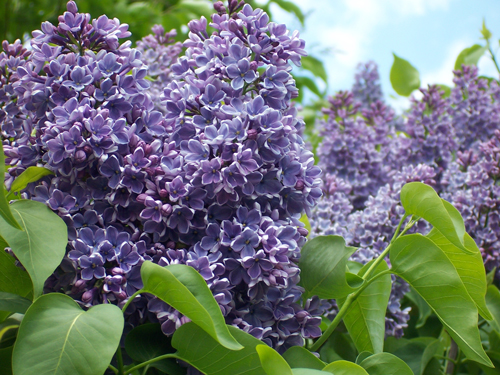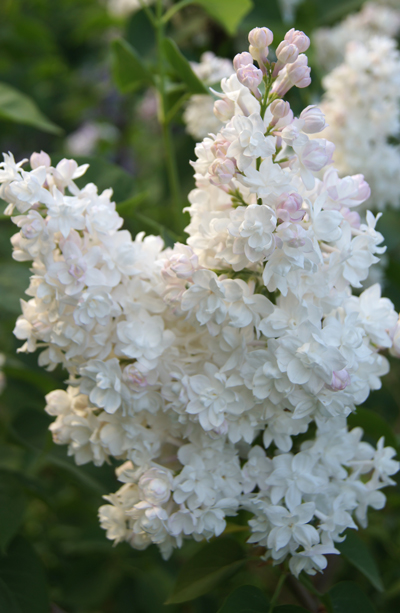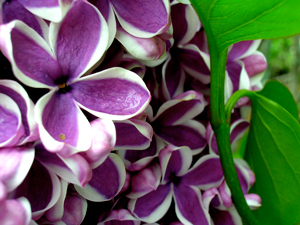by Donna De Palma


Scent is one of the most seductive qualities known. Throughout history, scent has lured, provoked, and even taunted the senses. No wonder the fragrant and delicate lilac’s early history, though largely unrecorded, is referenced as far back as Greek mythology.
Syringa vulgaris, the common lilac, is believed to have originated on the Balkan peninsula. Its appearance in cultivation dates to the 15th Century. A species of flowering plant in the olive family, Syringa vulgaris is a large shrub that grows on rocky hillsides by the shores of the Adriatic, Mediterranean, Aegean and Black Seas. Other fragrant, flowering species of lilac are native to regions of Japan, China and Korea.
According to Mark Quinn, Monroe County Parks’ superintendent of horticulture, while there are no written records of the lilac’s arrival in the United States, there is evidence that lilacs grew in Portsmouth, New Hampshire in the 1600s.
Cultivars have evolved thanks to dedicated breeders seeking to improve on the natural beauty and scent of the fragrant flower, its disease resistance and overall plant habit. Irene Lekstutis, landscape designer at Cornell Botanical Gardens in Ithaca, who is responsible for selecting lilacs for inclusion there, says breeders have contributed to the structure, color and scent of the lilac over the past four centuries.
“Horticulturalist Victor Lemoine played an important role in developing cultivars of lilac in the mid-nineteenth century in France. Lemoine developed the first double-flowered hybrid lilac named for his wife, Mme. Lemoine,” says Lekstutis.
Father John Fiala of Ohio, pastor and school principal who bred 78 cultivars of lilacs, is also identified by Lekstutis as another significant breeder in the 20th century. He learned about gardening and horticulture from his grandmother at her country home in Michigan.
Perhaps the most prized collection in the United States, and arguably the world, is the one at Highland Park in Rochester. With more than 550 varieties and around 1,200 bushes, Highland Park’s Annual Lilac Festival, originally just “Lilac Sunday,” has been drawing lilac lovers since 1905. The event developed into a 10-day festival in 1978.
Highland Park was established on twenty acres of land donated by George Ellwanger and Patrick Barry in 1888. George Ellwanger immigrated to the U. S. from a small farm near Wurttemberg, Germany, in 1835. Ellwanger grew up tending grapes and making wine with his father and brothers in his native country. He harbored a love of horticulture throughout his life and possessed a strong sense of civic responsibility.
Patrick Barry immigrated to the U.S. from Belfast, Ireland, in 1836 and began his working life in America at what was the oldest nursery in the United States at the time, Linnaean Nursery in Flushing, N.Y. He began his partnership with Ellwanger in 1840. Ellwanger and Barry owned Mount Hope Nursery (also known as Ellwanger and Barry Nursery), the largest nursery in the U. S., from 1840 to 1850.
The civic-minded business partners donated the first 20 acres of land to establish an arboretum on the undeveloped land where Highland Park stands today. Their donation was instrumental in the formation of a parks department in Rochester. Ellwanger also donated an observation pavilion atop the hill near the reservoir in the park. The Children’s Pavilion, also known as the Ellwanger & Barry Memorial Pavilion, was dedicated in 1890. [The pavilion was torn down in 1963 due to disrepair, but a campaign is underway to finance its reconstruction starting in 2022.—Ed.]
Frederick Law Olmsted was hired to design the park. Olmsted, the designer of Central Park in New York City, is often referred to as the father of American landscape architecture. He was at the pinnacle of his career when he designed Highland Park, which, according to Quinn, is a phenomenal example of Olmsted’s genius.
“The landscape architect’s style highlights natural attributes of the terrain,” says Quinn. “Olmsted’s ability to create one view that moves into another was remarkable. He used natural materials to screen out city views.”
Superintendent Quinn says the design of walkways and the park’s layout are perhaps its finest features. “Where Olmsted shined was in his understanding of what plants would look like when they matured. He planned for a park that would mature naturally and beautifully.”
Lekstutis says Olmsted had a clever way of separating vehicular and pedestrian features and saw the importance of water fixtures in a park. “Olmsted liked to play with terrain. He applied ways of structuring space to create visual screens and expansive lawns and was expert at handling adjacent spaces. His work illustrates how the beauty of a naturalistic landscape is important to supporting our well-being and therefore should be accessible to everyone.”
While current numbers place the count of lilac bushes in the park at around 1200, John Dunbar planted the first 100 at the corner of South and Highland Avenues in 1890. In addition to creating several new cultivars, Dunbar developed the evergreen forest (pinetum) on the north side of the park and planted lilacs on the south side of a landmark hill in the park.
Quinn says that while some varieties have been lost, an original vulgaris lilac bush from 1892 still blooms every May in the park. “Some of the varieties that are cultivated may not be strong enough to last, but most varieties that exist in upstate New York can be found here at Highland. We actively seek out new varieties every day. We’ve had a collaborative relationship with Arnold Arboretum of Harvard University in past years.”
Why has the lilac become such a popular shrub and flower here and around the world? Quinn says the climate in Rochester is suited to lilacs. “They like cold winters and warmer springs. Lilacs are hardy and easy to grow. The plants themselves are aggressive growers. Deer don’t like the lilac. Lilac shrubs can grow to 15 to 20 feet tall and some can last for a hundred years.”
“The main reason for poor bloom is because it’s either been planted in a shady spot or the shrub has been pruned at an incorrect time of year. Lilacs prefer dry soil. The amount of rain over the course of the year will affect the vigor of their blooms,” Quinn says.


While the plants themselves are hardy, their flowers can be affected by high winds, heavy rain, and too much heat once open. Relatively warm days and cool nights with moderate rain are optimal conditions for a long bloom period.
Quinn says lilacs in bloom are most fragrant in early morning and at early evening. The introduction of radial doubling, bicolor flowers and double-floret and four-floret flowers through cultivation has resulted in a wide array of varieties in appearance, scent, and form. From deep purple to French blue, pink, dusty pink, lavender, white, and yellow, cultivars come in a breathtaking palette of colors.
One of Quinn’s favorites is the ‘Rochester’ lilac, a white, radial-doubling bloom developed in Rochester. Another favorite, ‘Sensation’, features a deep purple bicolor flower with a white rim. For its luxurious scent, Quinn recommends ‘Fenelon’, a variety of S. hyacinthflora lilac, an early bloomer that he says is one of the most fragrant of any lilac.

Lekstutis enjoys ‘Beauty of Moscow’, a lilac flower with pink buds that turn white. ‘Scent and Sensibility’, a dwarf mounding shrub with its dark pink buds that turn lavender pink once opened, is another favorite. Finally, repeat blooming purple lilac, ‘Bloomerang’, a cultivar that blooms after first blush into summer and fall is a noteworthy addition to Lekstutis’s best picks.
Nature’s colorful, fragrant display is set to bloom on schedule this year as it has almost every year for over 100 years each and every spring. Quinn projects this year to be on track for hardy blooms during Highland Park’s Lilac Festival.
To enjoy these and all of the varieties growing at the park, visit the festival or wander through its winding paths when these lovely flowers are in bloom.
Donna De Palma is a freelance writer based in Rochester.
Views: 1






